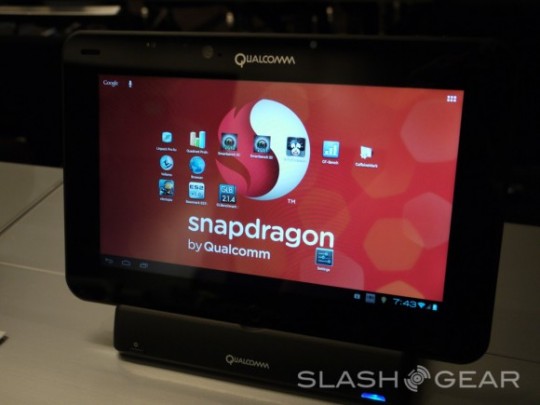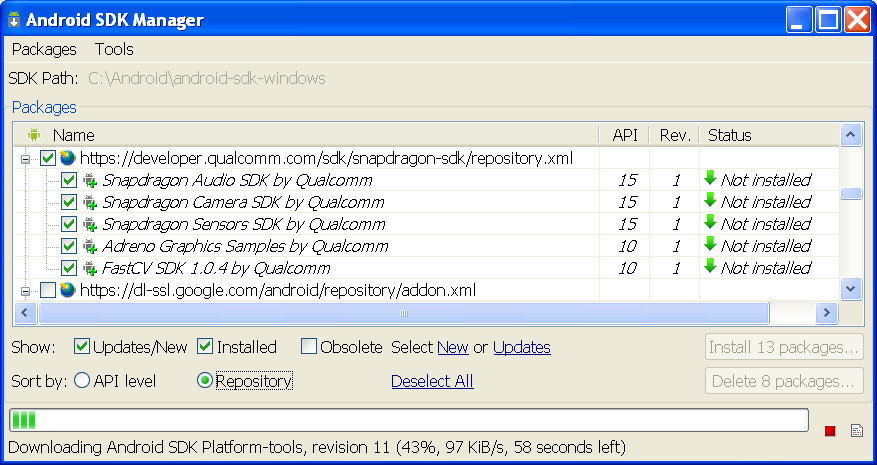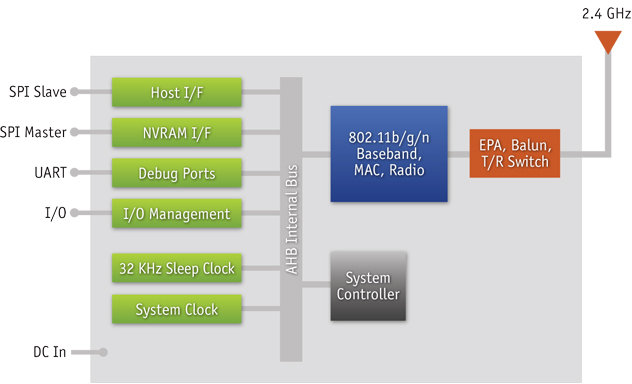Qualcomm has just announced their new Vuforia SDK 2.0 for Android and iOS to enable developers to create augmented reality applications for those platforms. Key new features include: Cloud Recognition Service – Up to now developers were limited to about 100 images on the target device due to limited storage space, but thanks to the Cloud recognition service, apps can “see” more than 1 million images, creating new mobile augmented reality (AR) opportunities for retailers and publishers. For example, every product (or image) in a store can bring associated content from the retailer’s website and render it directly on top of the product (or image). Watch American Apparel AR app video demo for an example of such app. The Cloud Recognition service requires a Vuforia Web Services account which is free for developers (Limited to 1,000 images, 3000 events per months), but is subject to fees for businesses. User-Defined Targets […]
Qualcomm Announces SnapDragon S4 MSM8226 & MSM8626 Quad Core Cortex A7 Processors
After news of an AllWinner A31 Tablet earlier today, here’s an other quad core Cortex A7 processor announcement, as Qualcomm has recently added of 2 new chipsets to its Snapdragon S4 family of mobile processors: the MSM8226 and MSM8626 featuring 4 ARM Cortex A7 core and Adreno 305 GPU. The processors support 1080p video playback and up to 13MP cameras. Both processors are built using 28nm technology node, and will be ready for customer sampling by Q2 2013 for UMTS, CDMA and TD-SCDMA. These 2 chipsets will incorporate WTR2605, a new multi-mode radio transceiver, specifically designed and optimized to address China requirements such as support for TD-SCDMA, CDMA 1xAdv and HSPA+. The WTR2605 transceiver comes with an integrated, high-performance GPS core with GLONASS and Beidou support, and is said to offer 40 percent power savings and 60 percent smaller footprint compared to previous generations. The company will also provide Qualcomm […]
Qualcomm Snapdragon S4 Pro Mobile Development Platform Is Now Available for $1299
A few weeks ago, Qualcomm showcased their new Snapdragon S4 APQ8064 processor with their tablet reference design at Uplink 2012. The platform (Snapdragon S4 Pro Mobile Development Platform for tablets (MDP/T)) is now available to developers for 1299 USD. This development tablet based on APQ8064 processor with Adreno 320 GPU comes with 2GB LPDDR2 RAM and 32 GB flash, features a 10.1” WXGA Multi-touch display, and runs Android 4.0. It will allows developers and manufacturer to develop, test, optimize and showcase applications and games for a wide range of pre-commercial Android devices. Here are the technical specifications of the Snapdragon S4 Pro APQ8064 MDP/T: Processor APQ8064 @ 1.5 Ghz (Quad core) PM8921+ PM8821 (PMIC) WCN3360 (WLAN/BT/FM) WCD9310 (Audio) WGR7640 (GPS) Graphics Adreno 320 graphics processing unit (GPU) Display 10.1” 1366×768 display True multi-touch capacitive touch screen Video 1080 High-definition video recording and playback up to 30 frames per second Stereoscopic […]
Qualcomm Showcases Quad Core Snapdragon APQ8064 Application Processor
Way back in February 2011, Qualcomm announced the Snapdragon APQ8064, a quad core application processor clocked at up to 2.5 GHz, that was (and still is) supposed to be available in products end of 2012, beginning of 2013. They now have samples, and showcased the processor in an Android tablet reference design at UpLink 2012. The APQ8064 is part of SnapDragon S4 Pro family and features 4 Krait cores running at up to 1.5 GHz when all four cores are running, or up to 1.7 GHz when only one core is active, according to Anandtech. So it appears they did not follow up on the 2.5 GHz promise. APQ8064 is the first SoC featuring Adreno 320 GPU, and will be followed by MSM8960 later on. The demo below shows the 3D performance of the Qualcomm processor and GPU, and Raj Talluri, Senior Vice President, Product Management at Qualcomm, claims the […]
Qualcomm Announces Snapdragon SDK 1.0 for Android
Qualcomm has announced the Snapdragon SDK for Android at the Uplinq 2012 developers conference, and a preview release of the SDK is now available on Qualcomm’s developer site. The full SDK will be available to device manufacturers and developers in the coming months. The Snapdragon SDK for Android enables developers to features of Snapdragon processors via Application Programming Interfaces (APIs) not otherwise available in the stock Android SDK including: Snapdragon Audio SDK (new) Snapdragon Camera SDK (new) Snapdragon Sensors SDK (new) Adreno GPU sample code for OpenGL ES FastCV SDK – Mobile-optimized Computer Vision (CV) library Supposedly, there is also IZat Location SDK, but it did not show up in the list when I tried it. At first, the SDK will only support devices build around Snapdragon S4 8960 processor, but the company expects to support future Snapdragon processors over time. The Snapdragon SDK for Android allows developers to take […]
Qualcomm Atheros AR4100P Provides WiFi Connectivity to the Internet of Things
In January, Texas Instruments was the first company (to my knowledge) to release a WiFi chip for the internet of things, the SimpleLink Wi-Fi CC3000, where WiFi is mostly implemented in hardware to lower power consumption. Now, the company has some competition with the announcement of Qualcomm Atheros AR4100P, an improved version of its AP4100 WiFi chipset, including IPv4/IPv6 support. The AR4100 targets the home, enterprise, smart grid and home automation and control applications that have lower data rates and transmit or receive data on an infrequent basis. The AR4100 system-in-package (SIP) features the following: Low energy Power saving modes as low as 5 µA Wake-up times as low as 2.2 ms Support for Quad SPI flash for faster wake times Low system resource requirements Low footprint host driver (25K Flash and 8K RAM) Simple, low-cost wireless system integration LGA package simplifies 2- or 4-layer PCB design Near zero RBOM […]
The AllJoyn Open Source Project – Android Builder Summit 2012
Marcello Lioy, Director engineering at Qualcomm Innovation Center, talks about AllJoyn open source project at then Android Builder Summit in February 2012: Description of AllJoyn project: AllJoyn is a peer-to-peer technology that enables ad hoc, proximity-based, device-to-device communication without the use of an intermediary server. True peer-to-peer communications without the traditional barriers Simple device and service discovery Security framework for authenticated and encrypted communications per application/service Managed networking and message routing Object-oriented programming model Optimized for the mobile embedded environment Low latency Header compression Reliable and unreliable transport Point-to-multipoint communications Potential applications of the technology include Multi-player gaming Social media sharing Multi-user productivity tools AllJoyn is part of Qualcomm Android development tools. I could not find the presentation slides for this particular talk. Jean-Luc Aufranc (CNXSoft)Jean-Luc started CNX Software in 2010 as a part-time endeavor, before quitting his job as a software engineering manager, and starting to write daily news, and […]
Qualcomm Releases Augmented Reality Vuforia SDK 1.5 for Android and iOS
Announced in January, Vuforia is the new name of Qualcomm’s Augmented Reality platform. Qualcomm has just announced the commercial release of Vuforia SDK 1.5 for Android and iOS. Applications built using this SDK can now be distributed and promoted on the Android Market and Apple App Store. Developers can also build 3D AR application using Qualcomm’s extension for the Unity 3 cross-platform game engine. The Vuforia SDK 1.5 supports Android devices running on Android 2.2 and above, as well as the iPad 2, iPhone 3GS, iPhone 4 and iPod touch (4th Generation) running iOS 4 and above. Vuforia SDK 1.5 brings the following features and improvements: Ability to swap datasets at runtime: You no longer have to upgrade your app to change the target dataset, and you can now build AR experiences that work on a large number of images. If your app needs to augment more than 60 images, […]







